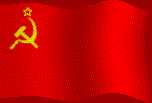HOME-click here






гимн союза советскихANTHEM OF THE SOVIET UNION (Russian) 
The Union of Soviet Socialist Republics (USSR),Russian: Soyuz Sovetskikh Sotsialisticheskikh Respublik (SSSR)), also called Soviet Union , SovNetsky SoyNuz), was a state in much of the northern region of Eurasia that existed from 1922 until 1991. The list of republics in the Soviet Union varied over the time. In its final years it consisted of 15 Soviet Socialist Republics (S.S.R.'s). Russia was by far the largest Republic in the Soviet Union, dominating in nearly all respects: land area, population, economic output, and political influence. The territory of the Soviet Union also varied, and in its most recent times approximately corresponded to that of the late Imperial Russia, with notable exclusions of Poland and Finland. The political organization of the country was defined by the only recognized political party, the Communist Party of the Soviet Union. History of the Soviet UnionRevolutionary activity in Russia began with the Decembrist Revolt, uncovered in 1825, and although serfdom was abolished in 1861, its abolition was achieved on terms unfavorable to the peasants and served to encourage revolutionaries. A parliament, the Duma, was established in 1906, but political and social unrest continued and was aggravated during World War I by military defeat and food shortages. The February Revolution and October Revolutions (see also Russian Revolution) were followed by a period of civil war (see Russian Civil War), after which communist control was complete under the Bolsheviks who soon renamed themselves the Communist Party. The collapse of Tsarist rule was followed by the eviction of the landlord class and the subdivision of land among peasant families. Poor and middle peasants generally did not benefit from the latter until Lenin announced the New Economic Policy (NEP), which saw an end to government requisitioning of food during the civil war. Peasants marketed most of their produce at free prices during the years of the NEP. After the death of the Soviet Union's revolutionary founding figure Vladimir Lenin (1924), Joseph Stalin finally emerged as uncontested leader, defeating Leon Trotsky and ultimately having him exiled from the Soviet Union in 1929. Under Stalin, who replaced Lenin's NEP with five year plans and collective farming, the Soviet Union (established 1922) became a major industrial power, but with effective political opposition eliminated during the 1930s by purges. World War II established the Soviet Union as one of the two major world powers, a position maintained for four decades through military strength, aid to developing countries, and scientific research, especially into space technology and weaponry. Growing tensions between the Soviet Union and the United States, its former wartime ally and the other superpower, led to the Cold War. Communist Party General Secretary Mikhail Gorbachev promoted Soviet glasnost (openness) and perestroika (economic restructuring). A U.S.-Soviet summit meeting in 1986 and 1987 and a meeting of U.S. President Ronald Reagan and Gorbachev in late 1988 brought a reduction in arms in Europe. The disintegration of Communist allies in Eastern Europe heralded the dissolution of the Soviet Union. As the Russian republic's Boris Yeltsin eclipsed Soviet leader Mikhail Gorbachev in power, the Soviet Union was peacefully dissolved in December 1991. Most former Soviet republics joined the Commonwealth of Independent States. Republics of the Soviet UnionThe Soviet Union was a federation of Socialist Soviet Republics (SSR). The first Republics were established shortly after the October Revolution of 1917. At that time, republics were technically independent one from another but their governments acted in close coordination. In 1922, four Republics (Russian SFSR, Ukrainian SSR, Belorussian SSR and Transcaucasian SFSR) joined into the Soviet Union. Between 1922 and 1940, the number of Republics grew to sixteen. Some of new Republics were formed from territories conquered by the Soviet Union, others by splitting existing Republics into several parts. The criteria for establishing new republics were as follows: to be located on the periphery of the Soviet Union so as to be able to exercise their alleged right to secession, be economically strong enough to survive on their own upon secession and be named after the dominant ethnic group which should consist of at least one million people. The system remained almost unchanged after 1940. No new Republics were established. One republic, Karelo-Finnish SSR, was disbanded in 1956. The remaining 15 Republics existed until the collapse of Soviet Union in 1991 and became independent countries, with some still loosely organized under the heading Commonwealth of Independent States. Some republics had common history and geographical regions, and were referred by group names. These were Baltic Republics, Transcaucasian Republics, and Central Asian Republics. |
